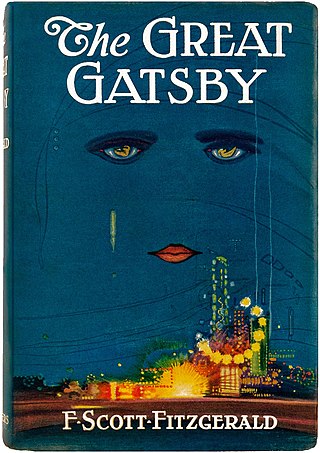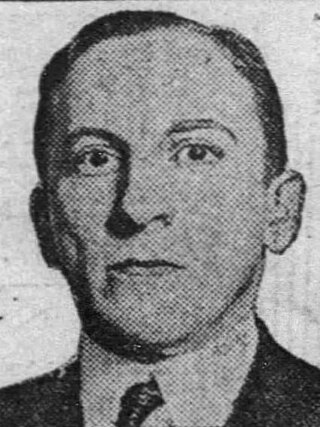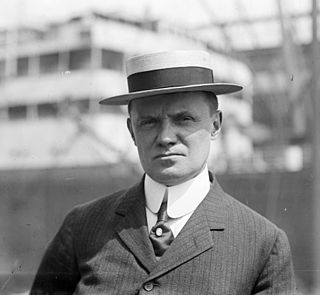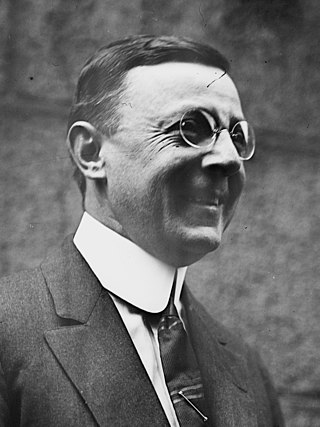
Times Square is a major commercial intersection, tourist destination, entertainment hub, and neighborhood in Midtown Manhattan, New York City, United States. It is formed by the junction of Broadway, Seventh Avenue, and 42nd Street. Together with adjacent Duffy Square, Times Square is a bowtie-shaped plaza five blocks long between 42nd and 47th Streets.

The Great Gatsby is a 1925 novel by American writer F. Scott Fitzgerald. Set in the Jazz Age on Long Island, near New York City, the novel depicts first-person narrator Nick Carraway's interactions with mysterious millionaire Jay Gatsby and Gatsby's obsession to reunite with his former lover, Daisy Buchanan.

Arnold Rothstein, nicknamed "The Brain", was an American racketeer, crime boss, businessman, and gambler who became a kingpin of the Jewish mob in New York City. Rothstein was widely reputed to have organized corruption in professional athletics, including conspiring to fix the 1919 World Series. He was also a mentor of future crime bosses Lucky Luciano, Meyer Lansky, Frank Costello, Bugsy Siegel, and numerous others.

Charles Seymour Whitman was an American lawyer who served as the 41st governor of New York from January 1, 1915, to December 31, 1918. An attorney and politician, he also served as a delegate from New York to the 1916 Republican National Convention. He had previously served as deputy and New York County District Attorney, in addition to state judge.

The Lenox Avenue Gang was an early 20th-century New York City street gang led by Harry Horowitz; it was considered one of the most violent gangs of the pre-Prohibition era. It was based in Harlem in Upper Manhattan, New York City, around 125th Street, in what was then a predominantly Jewish neighborhood.

"Big" Jack Zelig was an American gangster and one of the last leaders of the Eastman Gang.

Charles Becker was a lieutenant in the New York City Police Department between the 1890s and the 1910s. He is known for the scandal of being convicted of first-degree murder and subsequently executed for the killing of Herman Rosenthal, a bookmaker and gambler, in 1912 near Times Square.

Jay Gatsby is the titular fictional character of F. Scott Fitzgerald's 1925 novel The Great Gatsby. The character is an enigmatic nouveau riche millionaire who lives in a luxurious mansion on Long Island where he often hosts extravagant parties and who allegedly gained his fortune by illicit bootlegging during prohibition in the United States. Fitzgerald based many details about the fictional character on Max Gerlach, a mysterious neighbor and World War I veteran whom the author met while living in New York City during the raucous Jazz Age. Like Gatsby, Gerlach threw lavish parties, never wore the same shirt twice, used the phrase "old sport", claimed to be educated at Oxford University, and fostered myths about himself, including that he was a relation of the German Kaiser.

Harry Horowitz, also known as "Gyp the Blood", was an American underworld figure and a leader of the Lenox Avenue Gang in New York City.

The Great Gatsby is a 1974 American romantic drama film based on the 1925 novel of the same name by F. Scott Fitzgerald. The film was directed by Jack Clayton, produced by David Merrick, and written by Francis Ford Coppola. It stars Robert Redford, Mia Farrow, Sam Waterston, Bruce Dern, and Karen Black. The plot concerns the interactions of writer Nick Carraway with enigmatic millionaire Jay Gatsby (Redford) and Gatsby's obsession to reunite with his former lover, Daisy Buchanan (Farrow), amid the riotous parties of the Jazz Age on Long Island near New York City.
Louis William "Bridgie" Webber was an underworld figure in New York City and a former associate of gang leader Monk Eastman who later testified against police lieutenant Charles Becker during his murder trial in 1912.

Jacob Rosenzweig was an American gambler and underworld figure in New York City. He was one of several star witnesses in the Becker-Rosenthal trial, among these being fellow gamblers Bridgie Webber, Harry Vallon, and Sam Schepps. Rose's testimony was the most damaging because he directly implicated Becker in arranging the murder of Herman Rosenthal. As Becker's debt collector, Rose confessed to hiring the Lenox Avenue Gang, providing the getaway car. He testified he did it all on the orders of Charles Becker.

Sam Paul was an American gambler and underworld figure in New York City at the start of the 20th century. Founder of the Sam Paul Association, he was also a major political organizer for Tammany Hall.

George Samuel Dougherty was an American law enforcement officer, private detective and writer. He was considered one of the leading detectives in the United States, first for the Pinkerton Detective Agency and then as a private investigator. Dougherty was responsible for the capture of many notorious criminals during the late 19th and early 20th centuries. He also introduced the modern-day fingerprinting to the police force.

Francesco Cirofici was an Italian-American criminal and gangster, who, along with Harry Horowitz, was responsible for the July 16, 1912 murder of gambler Herman Rosenthal outside the Hotel Metropole.

Samuel Schepps, also known as Schapps, was a New York City mobster with the Monk Eastman Gang. Schepps ran gambling houses for Jack Zelig as part of his work with the gang.

The Becker–Rosenthal trial was a 1912 trial in New York City for the murder of Herman Rosenthal(1874-1912), a bookmaker, by NYPD Lieutenant Charles Becker and members of the Lenox Avenue Gang. The trial ran from October 7 to October 30, 1912, and restarted on May 2 to May 22, 1914. Other procedural events took place in 1915.
This article is a timeline of the history of New York City in the state of New York, US.
On March 20, 2017, Timothy Caughman, a black 66-year-old man, was collecting cans for recycling in the Hell's Kitchen neighborhood of Manhattan, New York City when James Harris Jackson, a white 28-year-old man, approached him and stabbed him multiple times with a sword. Caughman later died of his injuries. Jackson subsequently turned himself in to police custody and confirmed that he traveled from Maryland to New York with the intention of killing black men in order to prevent white women from having interracial relationships with them.

Terminal City, also known as the Grand Central Zone, is an early 20th century commercial and office development in Midtown Manhattan, New York City. The space was developed atop the former Grand Central Station railyard, after the New York Central Railroad decided to rebuild the station into Grand Central Terminal, and reshape the railyard into a below-ground train shed, allowing roads and skyscrapers to be built atop it.



















